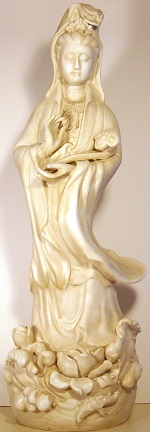About Serene Reflection Meditation
Great Master Dogen Zenji was the monk who brought the Buddhist tradition of Ts'ao-tung ch'an (Serene Reflection Meditation, J: Soto Zen) from China to Japan in the 13th century. One of the first things he wrote upon his return was Rules for Meditation, based on what he had learned from his time in the monasteries of China. In the Rules he writes, "Just sitting, with no deliberate thought, is the important aspect of serene reflection meditation.... This type of meditation is...simply the lawful gateway to carefree peace." In Soto Zen, the technical term for this type of "just sitting" meditation is shikantaza.
Unlike some other forms of meditation, Serene Reflection Meditation does not focus on objects of meditation, nor on koans (logical conundrums designed to exhaust the intellect and will). One "just sits," letting thoughts come and go, arise and pass away: "You neither think, nor try not to think." You do not push away painful thoughts of loss, regret, resentment, guilt, jealousy, shame and so on, neither do you cling to pleasing, self-satisfying thoughts. By not clinging to either of these opposites, which are conditioned by the egocentric self, the meditator experiences the "third position" beyond them which reflects the True Self, our True Nature. Dogen emphasized that in practicing this type of meditation we are not trying to "get enlightened" or anything else; that the very act of meditation is enlightenment itself. And when we truly bring our meditation into daily life — live our meditation in daily life—we are ipso facto living an enlightened life. And, in addition to ourselves, this cannot help but positively affect everyone and anything we come into contact with in our daily life.
Together with meditation, another essential component of the Serene Reflection Meditation tradition is the Buddhist Precepts. These provide the moral framework of the Buddhist life. They are not so much moral injunctions or proscriptions as they are descriptions of a way of living that is in harmony with our True Self, our True Nature. Click here for a page devoted to Precepts. (Top ⇑)
About Reverend Master Jiyu-Kennett
Just as Dogen Zenji journeyed to China and brought the teachings of Soto Zen to Japan so, too, did Rev. Master Jiyu-Kennett travel to Japan and bring the teachings to the West. She understood, as did her Japanese master, that for Buddhism to flourish in the West it needed to adapt to the cultural soil in which it was being transplanted while "staying true to the Source"—the spiritual essence of the teachings. One of the great gifts that Rev. Master Jiyu offered to the West were translations of the core scriptures of Soto Zen into English that she made with the guidance of her Japanese teachers. Moreover, because of her experience as a church organist she was able to set these scriptures to Western forms of plainchant that resonate in our Western "cultural DNA."
The following biographical sketch of Rev. Master Jiyu-Kennet was written by the Abbot of North Cascades Buddhist Priory, Rev. Master Koshin Schomberg. It is included in his website at howtogrowalotusblossom.org.
Rev. Master Jiyu-Kennett was born in England in 1924. She was a gifted musician and composer, She received her formal education at Trinity College of Music, London, and held the degree of Bachelor of Music from Durham University. She was drawn to a religious vocation at an early age, though she was unable to fulfill her longing for the renunciate life until her mid-thirties. She studied Buddhism with the eminent Sri Lankan teacher, Venerable Professor Saddhatissa in London, and became a member of, and taught classes at, the Buddhist Society. She met the Very Reverend Keido Chisan Koho, Zenji, Chief Abbot of Soji Temple, Yokohoma (one of the two main monasteries of the Soto Zen Tradition of Buddhism in Japan) in London when he was on a visit to the West. He invited her to come to Japan to train as his monastic disciple. In 1961, she left England and travelled first to Malaysia, where she was ordained as a monk by the Venerable Seck Kim Seng, Abbot of Cheng Hoon Teng Temple in Malacca. She then went on to Japan where she became the monastic disciple of Koho Zenji. She received Dharma Transmission from Koho Zenji and was named by him as a Dharma Heir. She served as Foreign Guestmaster of Soji Temple. After her master's death, she returned to the West. She founded Shasta Abbey in Northern California in 1970. She also founded Throssel Hole Buddhist Abbey in Northumberland, England, and is revered as the Founder of many other temples started by her disciples and grand-disciples, including North Cascades Buddhist Priory (the temple of which this writer is the abbot). Rev. Master Jiyu-Kennett died in 1996. She left a profound legacy of Teaching.
When Rev. Master Jiyu-Kennett arrived at Soji Temple as a new trainee, she was asked, "What do you seek?" She replied, "The Perfection of Zen!" Her training and teaching throughout the rest of her life demonstrated her commitment to living the Perfection of Zen. [Her book] How to Grow a Lotus Blossom shows that Perfection in a unique and magnificent way. (Top ⇑)
About Reverend Bennet
Rev. Bennet (David) Laraway was born and raised in rural Hutchinson, Minnesota. He graduated from Hutchinson High School, served four years in the Coast Guard, then went on to receive a B.A. and M.A. in English from the University of Minnesota, Minneapolis, and also attended McGill University in Montreal, Canada.
If you have questions, or would like to speak to Rev. Bennet, please email northstardharmarefuge@outlook.com or call 320-455-7607. (Top ⇑)



